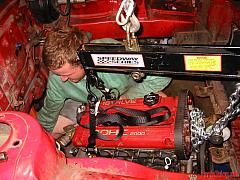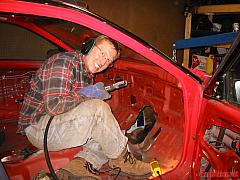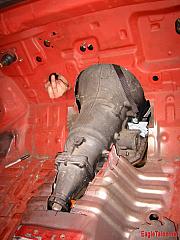Turning the engine sideways so that we’d be able to get the power to the rear wheels wasn’t too big an ordeal, but it was something that was a bit errie. I mean here I’ve got this car, my car, and I’m cutting the shit out of it. It just didn’t seem right at times, but it was still amusing. Most of the time I wasn’t too freaked out by actually cutting up the car – My general thought was “Eh, it’s just steel, I can weld more abck in if I need to.” We weren’t quite sure which transmission to use – Mark was all about a transmission with a lockup convertor, and I wanted to use a TH350 or TH400. I was more about the TH400, but talking to some Chevy guys, learned that the TH350, if built well, would handle all the torque I could throw at it. Through a friend, I picked up a TH350 on trade for some other work. It was cheap, and even if I didn’t end up using it, I would still be able to use it for mockup purposes. The TH400 would potentially be a little longer, but the TH350 worked for now. Here’s the cool thing: The way the rear crossmember, and the rear differential sat in the car, we would have a 0 degree angle on the pinion, and a 0 degree angle on the transmission… but only if we used mounted the engine in the car ~4″ lower than it was previously. Was that even possible? Well, not with the stock oil pan, but that’s okay, because the stock pan had to go. What’s even better is that the stock cam gears cleared the hood, so we wouldn’t even have to cut up the hood, or install a cowl or anything like that. It’d sit tightly under the factory steel, with a little room to spare. In addition to that, the ass end of the car was also spec’d out to sit at stock right height, even though the new slicks were 29.5″ tall, ~6″ taller than the stock tires on the car. All this is in fact intertwined with how we’d turn the engine 90 degrees, so that it sat “right” in the engine bay, in V-8 terms, anyway. We needed to make sure we had room, the engine could sit level, center, and square in the car. So, all those other things I just mentioned played a large factor in that. Once we did all that, we had the engine and transmission on a hoist, ready to weld in place. So, it was time to figure out mounting locations. The engine plate would end up being the mid-mount for the engine / transmission, with a bar going across the front for a front engine mount, and a bar going under the tailshaft of the transmission as the rear engine mount. Now, mind you, this was a good chunk of the weight of the car. Altogether, this stuff probably weighed in excess of 500 pounds. In addition to that, the engine was expected to make torque like whoa, so It’d need to be able to handle that. So, since the mid plate was so hefty, we decided to use that as the main engine mount. We welded tabs to the midplate so that the entire assembly would bolt up to the engine mounts without an issue. After that, we constructed some solid mounts out of some 1/8″ 1018 mild steel. They’re solid! We cut and welded the main pieces of steel for the mid mount, and then created the chromoly front engine mount, and rear engine mount, also out of chromoly tubing. That stuff is 1-1/4″ .065″ wall, I think (It’s been a while.) After that, we finished up the mid mounts by boxing them in, and painted them up for a nice finish 🙂




